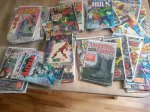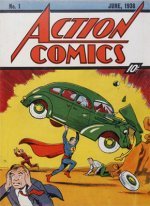Comic Book Grading Guide
This basic comic book grading guide is designed to help you sell comic books you have found, bought, or inherited.
It's not meant to be an expert guide to grading comic books. In fact, I'm far from an expert.
But I CAN teach you to quickly assess about what your comic book grades at, and therefore, roughly what your comic book is worth.
That is all the skill you will need to determine the average grade of your comic books. Once you have that information, it will be a lot easier to get them appraised.
The Mint Condition Myth
The most common problem with comic book grading is, it's subjective.
Most people see a comic from the 1980s in a plastic bag and presume that it's "mint condition". You see this all the time:
"Collection of vintage comics, still in original bags, mostly 1980s and 1990s, mint condition!"
There are several problems with that description.
- Almost NO comics came in bags
- The comics may have been put in bags last week after 25 years stuffed in a box.
- You need the right kind of bags, and acid-free backing boards.
- Most people see 'little faults' (like creases across the corner) and presume they are unimportant.
Truly mint condition comics, even from as recently as the 1980s, are very hard to come by.
This is extremely important if you're buying comics. It's less important if all you want to do is sell some comics you've found, or inherited.
Comic Book Grades Explained
Comic book grading is based on a score out of 10:
- 0-1.5 = poor to good minus
- 2.0-3.5 = fair to very good minus
- 4.0-5.5 = very good to fine minus
- 6.0-7.5 = fine to very fine minus
- 8.0 = very fine
- 8.5 = very fine plus
- 9.0 = very fine/near mint
- 9.2 = near mint minus
- 9.4 = near mint
- 9.6 = near mint plus
- 9.8 = near mint to mint
- 9.9 = mint
- 10.0 = gem mint
Let's show you some examples, so you can understand what YOUR books grade on this scale.
What a Fair (1.0 Graded) Comic Book Looks Like

Worn, torn, stained, tape repaired, written on, cover loose, rusted staples, heavy creasing... These are all faults you will find on the worst condition comics.
NOTE: if a comic is incomplete for any reason (missing pages, coupons clipped, cover gone), it is virtually worthless.
What a Good (2.0 Graded) Comic Book Looks Like

It's still a pretty rough-looking specimen, but a good comic should at least be solid, readable, and relatively presentable.
Most of the faults found on poor comic books can apply. There should be a few less of them.
What a Very Good (4.0 Graded) Comic Book Looks Like

Very good comics still look well-read, but they're starting to seem less of a compromise for collectors who don't simply want to read their books.
This is the worst grade when it's acceptable to see tape repairs.
You should look at a very good comic and not feel embarrassed if a friend saw it in your collection.
What a Fine (6.0 Graded) Comic Book Looks Like

For most "serious" collectors, fine is the lowest acceptable grade.
While there can be wear, some minor creasing and other faults, a fine comic book usually has most of its cover gloss, and looks pretty nice at first glance.
It's more the sum of small faults (or one major one) that brings this book down from a higher grade.
Why This Guide is AWESOME for Wannabe Comic InvestorsIf you have either tried (and failed) to make money flipping comic books, or are frustrated by the huge array of choice out there, then this is the eBook for you. It's packed with 32 in-depth analyses of easy-to-buy and sell comic books from the Bronze to Modern ages. These are titles we have personally made a lot of money buying and selling. So can you. Make more than your money back with your first successful trade (or by NOT buying a losing book!). If you are not completely satisfied, we have a 365-day money-back guarantee. Click to read more, or order your copy today! |
What a Very Fine (8.0 Graded) Comic Book Looks Like

Now we're getting into the territory where the value of your comic books spikes up rapidly. The price difference between the value of a fine and a very fine comic book can be double or more.
Generally a very fine comic either is a near mint, with one nasty fault bringing it down, or a near mint, with a few minor faults bringing it down.
When you're comic book grading, you should be conservative. If in doubt between a near mint minus and a very fine, always presume it's very fine, and then the only surprises can be good ones.
You can expect an otherwise very nice cover to have one corner with a crease, some spine stress marks, a little wear. But it's a really nice looking comic.
NOTE: This is the grade that most inexperienced comic book graders think is "mint". So if you see a collection described as mint, presume it's actually very fine.
What a Very Fine/Near Mint (9.0 Graded) Comic Book Looks Like

Most near mint minus comic books have just one small fault bringing them down. Perhaps a patch of wear on a front cover edge, perhaps one corner creased and breaking color.
Almost anybody with no experience would call this comic "mint".
What a Near Mint Minus (9.2 Graded) Comic Book Looks Like

The most common fault at near mint is color breaking spine stress.
That, or a small, small corner crease.
Anything that breaks color is going to prevent this book from getting to 9.4 or higher.
What a Near Mint (9.4 Graded) Comic Book Looks Like

We're into super-picky territory here.
Sorry to say that MINT comics are really rare, and here's why. The hobby gets very petty when you're comic book grading near mint to gem mint comic books.
The tiniest spine stress takes you down 0.2. A fingerprint on an otherwise perfect gloss, or any gloss wear on the spine, takes it down from mint.
This really doesn't matter to you if all you want to do is sell an old collection you came into.
What a Near Mint Plus (9.6 Grade) Comic Book Looks Like

Even pickier than a 9.4, a 9.6 comic book can only have one very small fault really.
The cover should be more or less perfect, with no breaks in the cover gloss. The above image is hard to make out, but there's a small bump to the top of the spine.
Otherwise this book would grade 9.8.
What a Near Mint/Mint (9.8 Grade) Comic Book Looks Like

Call "mint" brand new minus. Somebody dared to read this once upon a long ago, and now the comic shows very minor signs of handling.
Otherwise, it's perfect.
Mint 9.9 or Gem Mint 10.0...
Forget it! These don't exist.
Well, okay, they DO exist, but only if a comic was bought and stored immediately in perfect conditions, and has never been disturbed since.
If you find anything this perfect, DON'T EVEN OPEN IT! Simply opening it could cause spine stress.
Need Help With Comic Book Grading?
If you have an old collection, but can't get your head around comic book grading, then take photos or scans and send details to us for a free appraisal.
We'll soon let you know what you have.







